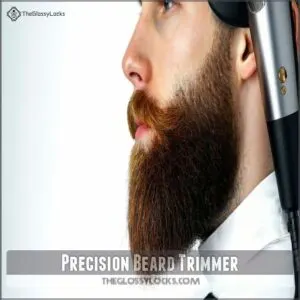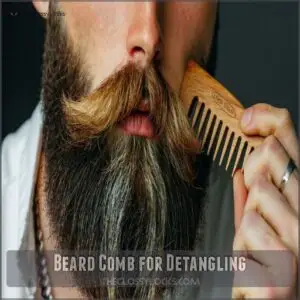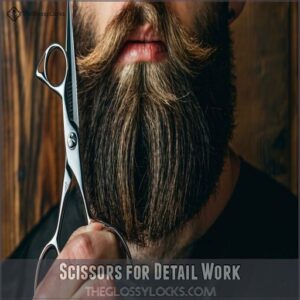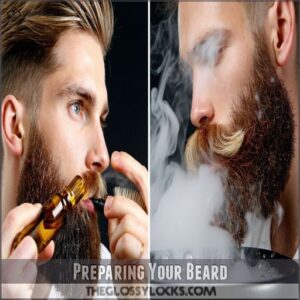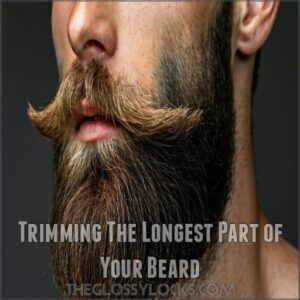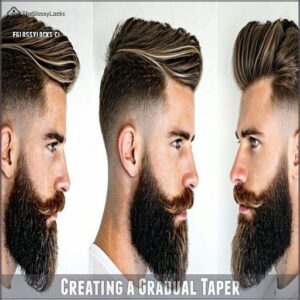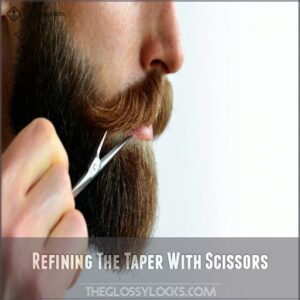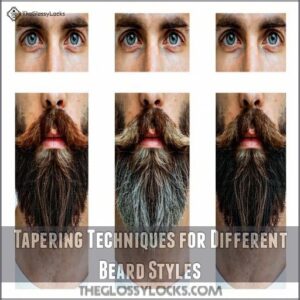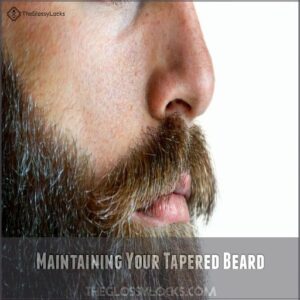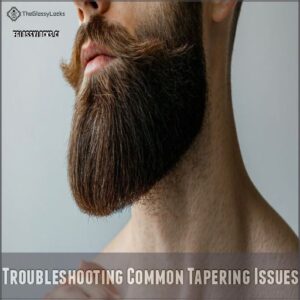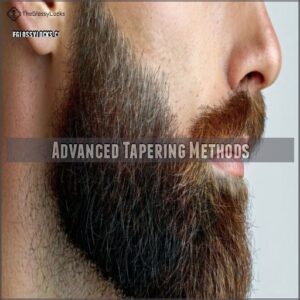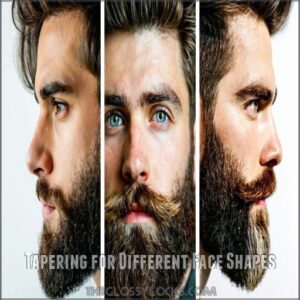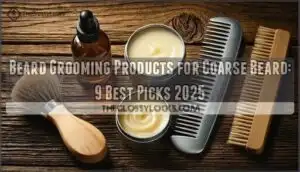This site is supported by our readers. We may earn a commission, at no cost to you, if you purchase through links.
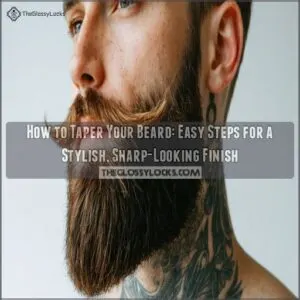 Ready to level up your beard game? Learning how to taper your beard is like giving your facial hair a custom-tailored suit.
Ready to level up your beard game? Learning how to taper your beard is like giving your facial hair a custom-tailored suit.
Start by grabbing a precision trimmer, wide-tooth comb, and beard oil.
Wash and detangle your beard, then define your neckline by placing two fingers above your Adam’s apple. Trim the longest part first, using progressively shorter guard sizes to create a smooth gradient from sideburns to chin.
Blend carefully with light, feathered motions, and refine edges with scissors. Pro tip: match your taper to your face shape for maximum style impact.
Want to transform your beard from basic to brilliant?
Table Of Contents
- Key Takeaways
- Essential Tools for Tapering
- Preparing Your Beard
- Establishing Your Desired Beard Shape
- Step-by-Step Tapering Guide
- Tapering Techniques for Different Beard Styles
- Maintaining Your Tapered Beard
- Troubleshooting Common Tapering Issues
- Advanced Tapering Methods
- Tapering for Different Face Shapes
- Enhancing Your Tapered Beard’s Appearance
- Frequently Asked Questions (FAQs)
- How do I taper down my beard?
- What does it mean to taper a beard?
- How to properly fade a beard?
- How to taper a beard neckline?
- How to taper a beard?
- Does castor oil help with the growth of a beard?
- What happens when you taper a beard?
- How do you trim a tapered beard?
- How often should you taper your beard?
- How should I taper my beard?
- Conclusion
Key Takeaways
- You’ll need precision tools like a quality beard trimmer, wide-tooth comb, sharp scissors, and beard oil to create a professional-looking taper that highlights your unique facial features.
- Mastering your beard’s taper involves understanding your face shape, choosing the right length, and using strategic trimming techniques that blend hair lengths smoothly from shorter sideburns to longer chin areas.
- Regular maintenance is crucial – you’ll want to trim every 2–3 weeks, establish a daily grooming routine, and touch up your edges to keep your tapered beard looking crisp and intentional.
- Don’t be afraid to experiment with different taper styles, as each beard is unique; practice creates confidence, and you’ll develop your own signature look that complements your personal style and facial structure.
Essential Tools for Tapering
You’ll need a few key tools to transform your beard from scruffy to sharp, so let’s talk about what’s in your grooming arsenal.
A precision beard trimmer, quality beard comb, sharp scissors, and nourishing beard oil are your secret weapons for creating a perfectly tapered look.
That’ll have heads turning.
Precision Beard Trimmer
Elevate your beard game with a precision beard trimmer – your secret weapon for killer tapers.
Not all trimmers are created equal, so choose wisely:
- Look for adjustable length settings
- Prioritize blade sharpness and durability
- Check battery life and charging speed
- Consider wireless flexibility for precise grooming
Master your beard’s destiny with the right tool in hand.
Beard Comb for Detangling
After nailing your trimmer setup, it’s time to tackle those beard tangles. Your secret weapon? A quality beard comb.
- Pick a wide-tooth comb that glides through knots
- Opt for wood or horn materials for gentler grooming
- Match comb size to your beard length
- Comb regularly to keep your beard looking sharp
Pro tip: A smooth, well-combed beard is the foundation of a killer taper. Grab that comb and show those knots who’s boss.
Scissors for Detail Work
Got your comb ready? Now grab those beard scissors – your precision cutting sidekick. These fine-tuned blades are perfect for edging techniques and shape refinement. They’ll help you tackle those tricky mustache lines and sideburn contours with surgeon-like accuracy.
| Scissor Type | Best For |
|---|---|
| Sharp Beard Scissors | Detailed Trimming |
| Professional Grooming Scissors | Precise Edging |
| Curved Scissors | Mustache Shaping |
| Straight Scissors | Neckline Definition |
| Ergonomic Scissors | Comfortable Control |
Snip confidently and watch your beard transformation unfold.
Beard Oil for Softening
Sharp scissors set the stage, but beard oil is your secret weapon for a smooth taper.
This liquid gold softens coarse hairs, making trimming a breeze while preventing skin irritation.
Choose oils packed with natural ingredients like argan or jojoba to nourish your facial hair.
By using a high-quality beard oil with soft beard oil benefits, you’ll be able to achieve a softer, shinier, and healthier-looking beard. * Pro tip: Warm a few drops between your palms before massaging into your beard, ensuring even distribution from root to tip.
Preparing Your Beard
Before you start tapering your beard, you’ll need to get it ready for a precision trim.
Washing, detangling, and applying beard oil will set you up for a smooth, professional-looking result.
That’ll have heads turning.
Washing and Drying Thoroughly
The ritual of pre-wash prep sets the stage for beard perfection. Your beard deserves a thorough cleanse with a quality beard wash in lukewarm water.
Gently pat your facial hair dry with a soft towel—no aggressive rubbing that could damage those precious whiskers.
A low-heat blow-dry can help see that your beard is completely dry.
| Technique | Purpose | Pro Tip |
|---|---|---|
| Lukewarm Wash | Cleanse | Use specialized beard wash |
| Gentle Towel Dry | Protect Hair | Pat, don’t rub |
| Low-Heat Blow Dry | Complete Drying | Keep dryer moving |
Detangling With a Beard Comb
After washing your beard, grab a wide-toothed wooden or metal comb to conquer those tangles.
For the best results when detangling, consider the benefits of using a high-quality beard comb, such as those found by searching for a best beard comb.
Your beard detangling mission starts now:
- Choose a comb matching your beard’s texture
- Work slowly from ends to roots
- Use gentle, consistent strokes
- Separate knots without pulling
- Comb when beard is slightly damp
Mastering this technique transforms messy facial hair into a smooth styling playground, setting you up for precision trimming success. This is essential for beard care. Detangling is key.
Applying Beard Oil for Smoother Trimming
Smoothing your beard with oil creates the perfect pre-trim canvas.
Different oil types cater to various skin needs, acting like a lubricant for precise trimming.
Massage a few drops through your facial hair, ensuring even coverage.
This magical elixir both softens your beard and makes tapering smoother and more controlled.
Establishing Your Desired Beard Shape
When you’re ready to transform your beard from scruffy to sharp, defining your desired shape is your first essential step.
You’ll want to carefully map out your neckline.
Choose your beard length.
Select a taper style that complements your face and personal style. This is key to achieving a sharp look.
Defining Neckline and Cheek Lines
When sculpting your beard’s neckline and cheek lines, precision is your secret weapon.
- Map out symmetrical cheek lines using your natural facial contours
- Create a clean neckline by placing two fingers above your Adam’s apple
- Use a sharp trimmer to define crisp edges without over-cutting
Master these techniques, and you’ll transform your beard from scruffy to sharp in minutes.
Determining Overall Beard Length
Picking your perfect beard length is an art form, blending personal style with natural growth patterns.
Your face shape, hair texture, and growth rate are key players in this grooming game.
| Face Shape | Recommended Length |
|---|---|
| Oval | Medium to Long |
| Square | Short to Medium |
| Round | Longer, Defined Edges |
Unlock your beard’s true potential by understanding its unique character.
Choosing Taper Style
Nail your beard taper by zeroing in on the perfect style that speaks to your unique look. Your beard fade isn’t just a trim—it’s a statement.
Consider these key elements to craft your signature taper:
- Match your taper length to your facial architecture
- Select a style that complements your beard density
- Explore fade directions that enhance your face shape
- Choose a technique that highlights your natural beard growth pattern
Master your beard, master your style.
Step-by-Step Tapering Guide
Ready to transform your beard from shaggy to sharp?
With the right technique, you’ll master the art of tapering.
creating a smooth, professional look that’ll have heads turning and compliments flowing.
Trimming The Longest Part of Your Beard
Now that you’ve defined your beard’s shape, it’s time to tame that facial forest!
Grab your reliable beard trimmer and set it to the right starting length.
You’ll want to work with the grain, using smooth, consistent strokes that follow your beard’s natural growth pattern. Pro tip: keep your trimmer at a uniform height to maintain an even distribution, which is essential for achieving a sharp look.
Start at the longest part of your beard, typically around the chin area, and trim carefully. Think of it like sculpting – you’re not hacking away, but gently refining your masterpiece, one careful pass at a time.
Creating a Gradual Taper
Gradually, your beard transforms into a work of art with smart tapering techniques.
Start by selecting your trimmer’s guard sizes strategically – this isn’t just cutting, it’s sculpting.
Begin at your sideburns with the shortest guard, then methodically increase length in the direction of your chin. Each small adjustment creates a seamless blend, softening harsh lines.
Think of it like painting: gentle, intentional strokes that gradually reveal your beard’s true potential. Precision is your ally here.
Blending Between Different Lengths
Master your beard fade with smooth gradient techniques that’ll have heads turning.
- Choose overlapping clipper settings
- Move guards incrementally
- Check symmetry frequently
- Use light, feathered motions
Your beard trimmer is your paintbrush, and each guard length is a different color on your facial canvas. Avoid harsh lines by flicking the trimmer upward in gentle strokes, creating a soft fade that looks natural. The key? Patience and a steady hand that whispers, not shouts, your style. smooth gradient techniques. pro-level look. blending tips
Refining The Taper With Scissors
After fine-tuning with your trimmer, scissors become your precision tool for beard perfection. Snip carefully at the edges to refine your taper, creating crisp lines and smooth blends. These small cuts make a massive difference in achieving that sharp, professional look.
| Beard Scissor Skill | Emotional Impact |
|---|---|
| Precision Cuts | Confidence Boost |
| Edge Shaping | Control Gained |
| Symmetry Check | Pride Released |
| Mistake Correction | Mastery Achieved |
Tapering Techniques for Different Beard Styles
Not all beard styles are created equal.
Mastering the right tapering technique can transform your look from basic to bold.
Whether you’re sporting a short, medium, or long beard, understanding how to taper your facial hair will help you achieve a clean, professional appearance that complements your unique facial structure. This will give you a clean, professional appearance.
Short Beard Taper
Craving a short beard taper that turns heads? Your journey starts with understanding your unique beard texture and face shape.
To maintain a professional appearance, weekly trimming is generally sufficient, although more frequent trimming may be necessary for individuals with rapid beard growth.
Grab a precision trimmer and map out your taper strategy. Focus on creating seamless shifts from shorter sideburns to slightly longer chin hair.
Pro tip: Use guard combs to control length and blend edges smoothly. With practice, you’ll nail that sharp, professional short beard taper.
Long Beard Taper
For guys rocking longer beards, mastering the taper is your ticket to sharp, professional style.
Grab your clippers and start at the cheek, gradually reducing length down to the sideburns. Work methodically, using different guard lengths to create a smooth, natural gradient.
Pro tip: keep beard oil handy to tame those longer locks and maintain a sleek, well-groomed look.
Faded Beard Taper
Ready to level up your beard game with a killer fade?
Understanding the principles of proper beard tapering techniques is key to achieving a professional look.
After mastering long beard styles, faded beard tapers are your next challenge. Grab adjustable trimmers and start experimenting.
Pro tip: blend your neckline softly, using different guard lengths to create that smooth, professional-looking fade. Your confidence will spike with each precise snip, transforming your facial hair from basic to bold.
Maintaining Your Tapered Beard
You’ve mastered the art of tapering your beard.
Maintaining that sharp look requires consistent effort and the right techniques.
Regular trimming, daily grooming, and strategic touch-ups will keep your tapered beard looking crisp, professional, and head-turning.
Regular Trimming Schedule
Beard maintenance isn’t rocket science – it’s an art of precision and timing.
Your beard fade’s lifeblood depends on a strategic trimming schedule suited to your unique growth rate:
- Weekly touch-ups to maintain crisp lines
- Bi-weekly length adjustments for evenness
- Monthly style refresh to keep things sharp
Your trimmer becomes your magic wand, transforming unruly facial hair into a masterpiece.
Daily Grooming Routine
One morning ritual can transform your tapered beard from scruffy to sharp: a strategic daily grooming approach.
Master your beard’s destiny with precision and care, starting with a quality beard wash that strips away daily grime.
| Wash | Condition | Style |
|---|---|---|
| Deep Clean | Hydrate Follicles | Define Edges |
| Remove Dirt | Prevent Breakage | Smooth Contours |
| Refresh Skin | Add Shine | Maintain Taper |
Comb through with purpose, apply nourishing beard oil, and finish with a light balm to lock in that crisp, polished look. This is a strategic daily grooming approach for a tapered beard. The morning ritual will transform your beard.
Touch-up Techniques for a Crisp Taper
After keeping your beard looking sharp daily, maintaining that crisp taper requires some strategic touch-ups.
To achieve a defined neckline, consider mastering a beard fade technique.
Your toolkit should include:
- Sharp razor for clean edges
- Precision beard trimmer
- Barber’s pen for line refinement
- Magnifying mirror for detailed work
Master these quick fixes, and you’ll keep your beard looking professionally styled between salon visits – no sweat.
Troubleshooting Common Tapering Issues
Even the most skilled beard tapers can run into frustrating moments that make you want to toss your trimmer across the room.
Don’t worry—we’ll walk you through common tapering pitfalls.
and how to fix uneven lines, tackle patchy areas, and keep your skin irritation-free.
Fixing Uneven Taper Lines
Uneven taper lines got you frustrated? No worries.
To achieve a sharp-looking finish, investing in a high-quality best beard trimmer can make all the difference.
Grab your trimmer and barber pen for precision line correction.
Smooth out those shaky edges with gentle, strategic strokes. Blend imperfections by carefully adjusting guard lengths and using a soft, scooping motion.
Master these re-shaping techniques and watch your beard taper transform from messy to masterpiece.
Correcting Patchy or Thin Areas
Battling patchy beard blues? Don’t sweat it! Your beard’s potential is just waiting to be tapped into.
Aiming for a full beard requires patience, as it can take at least 3 months to assess your beard’s growth potential beard growth timeline.
Here’s how to tackle those thin spots like a pro:
- Try beard fillers for instant coverage
- Use growth serums to stimulate follicles
- Experiment with strategic beard shaping
Embrace your unique beard journey – confidence is your ultimate styling.
Addressing Skin Irritation
Smoothing out those patchy spots can leave your skin feeling raw.
Prevention is your best friend: use a sharp trimmer, quality shaving gel, and a soft beard brush.
Using a beard care kit for sensitive skin can also help minimize irritation.
Soothe irritated skin with gentle aftercare products like cooling balms or natural remedies. Watch for allergic reactions, and always listen to what your skin’s telling you. Your beard’s comfort matters.
Advanced Tapering Methods
You’ve mastered the basics of beard tapering, and now it’s time to level up your skills with advanced techniques.
These pro-level methods will help you create custom tapers, blend like a barbershop pro, and give your beard that razor-sharp, professional finish that turns heads.
Freehand Tapering Without Guard Combs
When uneven lines threaten your beard’s swagger, freehand tapering becomes your secret weapon.
Ready to level up your grooming game? Here’s how to nail it:
- Use a razor with a steady hand
- Move with precision, not panic
- Practice creates beard-tapering mastery
Forget guard combs—true style comes from confident, controlled strokes that transform patchy problems into sharp sophistication.
Creating Custom Taper Patterns
After mastering freehand techniques, you’re ready to express your creativity with custom beard taper patterns.
Grab your precision trimmer and start experimenting with unique line designs that showcase your personal style.
Mix guard lengths, play with fade changes, and carve out sharp lines that highlight your facial features.
Your beard becomes a canvas – make it art.
Incorporating Beard Fades
Ready to level up your beard game? Incorporating beard fades transforms an ordinary taper into a masterpiece of style. Master your fade by experimenting with different trimmer guard lengths, creating seamless blends that showcase your personal flair.
- Feel the confidence boost of a perfectly blended beard
- Release your inner grooming guru
- Impress friends with pro-level styling skills
- Conquer beard fade challenges like a boss
- Turn heads with your razor-sharp look
Pro tip: Start with longer guards and gradually decrease length for a smooth, professional-looking fade that screams sophistication.
Tapering for Different Face Shapes
Not all beards are created equal, and your face shape can make or break your tapering strategy.
You’ll want to customize your beard’s fade to highlight your best features and create a balanced, flattering look.
This transforms your entire appearance.
Oval-Shaped Faces
If you’ve got an oval face, you’re in luck with beard styles!
Your gently sloping jawline and balanced features are perfect for experimenting with tapered looks.
Opt for longer taper lengths that enhance your natural symmetry – think Heavy Stubble or BeardStache.
The key? Use trimmers to create soft edges that frame your face, highlighting those killer cheekbones and creating a look that’s both sharp and effortlessly cool.
Square-Shaped Faces
Square up your beard game and tame those sharp angles with precision styling. Your square-shaped face demands a strategic approach to beard tapering:
- Soften chin corners with gentle, rounded edges
- Trim sides shorter to reduce facial width
- Create smooth jawline fades that showcase your structure
- Maintain perfect symmetry for a polished look
Master these taper techniques and transform your beard from boxy to bold.
Round-Shaped Faces
Round-faced fellas, your beard’s your secret weapon for adding definition! Don’t just grow – strategically taper to create jaw-dropping angles.
| Beard Vibe | Cheek Strategy | Visual Impact |
|---|---|---|
| Short & Sharp | High Definition | Chiseled Jawline |
| Medium Cool | Subtle Blend | Angular Magic |
| Long & Confident | Natural Flow | Face-Lengthening Illusion |
Craft your beard like a master sculptor, transforming round into remarkable.
Round-faced fellas and beard-shaping strategies are key to achieving a jaw-dropping look.
Enhancing Your Tapered Beard’s Appearance
A tapered beard isn’t just about trimming; it’s an art form that can transform your entire appearance.
You’ll want to explore color enhancements.
Pair your fastidiously crafted beard with complementary hairstyles to truly elevate your style and make heads turn.
Color Enhancement Techniques
Thinking about adding some color magic to your tapered beard? Color enhancement isn’t just a trend—it’s your secret weapon for standing out.
Grab a quality beard dye that matches your natural tone for seamless blending. Experiment with subtle highlights to add depth and dimension, making your beard pop.
Pro tip: Use beard balm to keep color looking fresh and vibrant.
Grey blending can transform your look, giving you a distinguished, intentional style.
Whether you’re covering greys or adding dramatic flair, choose beard care products that protect and nourish. Your beard, your rules—color it confidently.
Complementary Hairstyles
Your beard’s best wingman? The right hairstyle. Discover your style potential with killer beard-hair balance that screams confidence.
An undercut paired with a tapered beard creates sharp, clean lines that’ll turn heads. Want versatility? Try a pompadour that complements your facial hair’s natural flow.
Fade matches like top knots or combover styles can transform your look from basic to bold.
For men over 50 with thinning hair, hairstyles for older men such as the Thinning Pompadour or Crew Cut With Short Beard can also add a stylish touch.
Pro tip: Choose a hairstyle that echoes your beard’s length and texture. Whether you’re rocking a short, crisp taper or a more rugged style, your hair and beard should tell a cohesive story. The right hairstyle is key to a stylish look.
Frequently Asked Questions (FAQs)
How do I taper down my beard?
Scared of messing up your beard? Don’t sweat it.
Grab adjustable trimmers.
Start at the sideburns with a low guard setting, and gradually increase length down to your chin.
Flick upward for a smooth, professional-looking fade that screams confidence.
What does it mean to taper a beard?
Tapering a beard means gradually blending hair lengths from shorter at the sideburns to longer at the chin.
Creating a smooth, natural gradation that defines your facial hair’s shape.
Enhances your overall appearance.
How to properly fade a beard?
Want a sharp beard that turns heads?
Master the fade by starting with clean, dry facial hair.
Grab your trimmer, use guard combs strategically, and blend from short to long with smooth, upward flicking motions for a pro-level look.
How to taper a beard neckline?
Define your neckline two fingers above the Adam’s apple.
Use a beard trimmer with different guard lengths.
Gradually blending from shorter to longer hair.
Start with a lower guard number and work upward for a smooth, natural taper.
How to taper a beard?
Sculpt your beard’s destiny with precision!
Grab adjustable trimmers, start at sideburns, and gradually increase guard lengths.
Blend from shorter to longer hair, creating a smooth fade that transforms your facial landscape with confidence.
Does castor oil help with the growth of a beard?
You’ll see limited beard growth benefits from castor oil.
While it may moisturize and potentially stimulate follicles, scientific evidence is sparse.
It’s not a magic solution, but can help condition and potentially support healthier beard growth.
What happens when you taper a beard?
Ever tried beard magic?
When you taper your beard, you’re basically giving your facial hair a makeover.
Gradually blending shorter stubble near your sideburns to luscious length at your chin, creating a smooth, sophisticated look.
How do you trim a tapered beard?
Grab sharp trimmers with length guards and start tapering from sideburns.
Gradually increase guard sizes toward your chin, making gentle upward and downward movements.
Maintain symmetry, follow beard growth, and trim carefully for a smooth, professional-looking fade.
How often should you taper your beard?
You’ll want to taper your beard every 2-3 weeks to maintain its sharp look.
Regular touch-ups prevent awkward growth and keep your fade crisp.
so grab those trimmers and show your facial hair who’s boss!
How should I taper my beard?
With 85% of men struggling to achieve a perfect beard fade.
Start by washing your beard, then use adjustable trimmers.
Carefully blend guard lengths from sideburns to chin, creating a smooth gradient that transforms your look effortlessly.
Conclusion
Ultimately, mastering how to taper your beard is an art that transforms your look from ordinary to extraordinary.
You’ll boost confidence with each precise trim, creating a style that’s uniquely yours.
Remember, patience and practice are key – don’t get discouraged if your first few attempts aren’t perfect. Keep experimenting, stay consistent with your grooming routine, and you’ll soon rock a tapered beard that turns heads and reflects your personal swagger.

